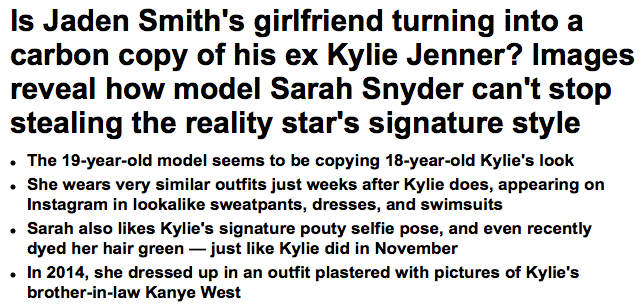by Marin McCall
Missing White Woman syndrome, Single White Female disorder, and the Basic White Girl: a media phenomenon, a serious case of copycat and a meme turned Halloween costume turned… new species? These three recurring themes in the dialogue of American pop culture analysts have implications beyond the content of today’s media: they mask alarming mainstream attitudes about all aspects of society.
Missing White Woman Syndrome
Missing White Woman syndrome refers to the extensive media coverage of violent crimes against white women and the lack of coverage of violent crimes against any other race, sex or gender. A 2008 study published through the International Communication Association finds that media outlets determine the newsworthiness of a violent crime story by youthfulness, attractiveness and body size. This trend has also found its way into TV and movie writing (the victims of fictional crimes often being young, attractive, white females).
The simple explanation: journalists determine the newsworthiness of a story by audience responses and audience demand. Audiences respond to stories about Susie Q from across the cul-de-sac, and tune in to the news every night to see if she will return to see her kindergarten graduation, demand to see what monster would touch a hair on her pretty blonde head.
Other explanations for the disparity in media coverage among demographics have to do with societal attitudes and the psychology of reporters.
The first is the obsession with the damsel in distress, harkening back to widely read and reproduced European fairy tales. The damsels in these stories were white, pretty, young women in need of rescue, and like these fictional stories, real-life stories similar to these sell.
The second is the societal perceptions of masculinity and femininity. According to the Wall Street Journal, as of 2014, 51 percent of missing person reports were missing females, as opposed to 49 percent missing males; however, media reports of missing persons were overwhelmingly reports of missing females. Because masculinity is often associated with strength and the ability to protect, society may view an abducted male as having failed in some aspect, rather than being the victim of a crime and viewers do not respond well to this angle. Femininity is often associated with fragility and dependency, so these stories are met with pity, concern and a call to action.
Lastly, the demographics of the newsrooms themselves may affect the types of stories being reported. According to PEW Research, in 2013 minority reporters were only 12 percent of the newsroom workforce and women of all races were underrepresented in newsrooms. The dominance of white males in the newsroom could explain Missing White Woman syndrome: white journalists subconsciously are drawn to stories about people to whom they relate (read: whites), and men are more likely to view women as damsels in distress.
 There has been a response to Missing White Woman syndrome in the Rilya alert system. The AMBER alert system (which has definitely benefited victims across the country) was named for a young, white girl who went missing. The Rilya alert system was named for a missing young, black girl, and seeks to do the same good by reporting missing person cases involving persons of nonwhite races under the age of 18. It seeks to not devalue the Amber Alert System, but simply hopes to correct and bring awareness to the lack of coverage given to minority children, especially black children (who make up an estimated 42 percent of missing children cases).
There has been a response to Missing White Woman syndrome in the Rilya alert system. The AMBER alert system (which has definitely benefited victims across the country) was named for a young, white girl who went missing. The Rilya alert system was named for a missing young, black girl, and seeks to do the same good by reporting missing person cases involving persons of nonwhite races under the age of 18. It seeks to not devalue the Amber Alert System, but simply hopes to correct and bring awareness to the lack of coverage given to minority children, especially black children (who make up an estimated 42 percent of missing children cases).
Single White Female Disorder
Single White Female disorder is a term inspired by the 1992 erotic thriller Single White Female. In the film, a woman, Hedy, attempts to assume her roommate, Allie’s, identity due to the psychological trauma Hedy suffered after her twin sister’s accidental drowning. Hedy dresses like Allie, gets an identical haircut to Allie and kills Allie’s friend and boyfriend when they threaten to tell Allie that Hedy is dangerous. The term “Single White Female disorder” describes a woman who exhibits similar behavior to Hedy, specifically imitation, clinginess and jealousy.
The film itself and the “disorder” to which it lends its name contribute to the negative portrayals of mental illness in society. Analysts of the film theorize that Hedy exhibits traits of some variation of bipolar disorder, though Allie says in the conclusion of the movie that Hedy suffered from survivor’s guilt. In either case, the film adds another character to the laundry list of static, one-dimensional, often violent and villainous characters suffering from mental illness. The appropriation of the term “Single White Female disorder” to the common vernacular enhances the effect of these characters on societal attitudes and misunderstandings toward mental illness.
Another problem with the adoption of this term in popular culture is that the term has been used to pit women against each other. Frequently, women use the term in everyday situations to describe clingy or jealous women imitating their looks or style. This term effectively conflates similarity to another woman with mental illness and the violent tendencies portrayed in the movie. Basically, if a woman follows a trend or imitates the style of someone else too closely, she is deemed to be on the same “crazy” level as a psycho stalker and killer. In the media, the term has been cited in instances of actual competition, like The Bachelor, or in perceived competition, such as competition between a new girlfriend and ex-girlfriend, or a star of less fame “copying” the style of a more famous star. Recent news articles citing Single White Female disorder deal with Jaden Smith’s new girlfriend, Sarah Snyder, who is accused of copying Kylie Jenner’s (Jaden’s ex girlfriend) personal style. Even Gwen Stefani’s nanny and husband’s mistress was slammed for “copying” Gwen’s personal style.

The use of the term Single White Female in these situations not only threatens the healthy support of women by women that is needed for feminism to thrive, but combines the perceptions of competition between women with the mentally ill and violent tendencies depicted in the film.
The Basic White Girl
The Basic White Girl, as defined by Urban Dictionary, is a white female who enjoys “Starbucks, Uggs, Lots of selfies, Dog pictures, I love you all over tumblr, Heart emojis, Leggings as pants, Forever 21, iPhone…” among other mainstream objects and practices. The Basic White Girl, according to white female rapper Kreayshawn, is just someone who likes what’s typical to like… She likes those normal brands and wears them all the time because that’s some basic shit.”
The term “basic bitch” originated in hip-hop culture, originally intended to assert the user’s superiority through uniqueness. The term has retained its purpose, but has gained racial and class associations in the addition of “white” and in the high cost of certain products like iPhones and Uggs, that have become essential to the stereotype. The term has gained popularity as a meme and even a Halloween costume.
 Underneath the light-hearted rejection of mainstream culture, the term “basic bitch” reveals misogyny in those who use it. The term simplifies women to the mainstream products that they use, and suggest that because of their personal style and no other analysis of their personality, they are “basic.” Beyond suggesting a stereotype among white females, the term, especially in its use of the word “bitch,” suggests the inferiority of the woman who enjoys mainstream things.
Underneath the light-hearted rejection of mainstream culture, the term “basic bitch” reveals misogyny in those who use it. The term simplifies women to the mainstream products that they use, and suggest that because of their personal style and no other analysis of their personality, they are “basic.” Beyond suggesting a stereotype among white females, the term, especially in its use of the word “bitch,” suggests the inferiority of the woman who enjoys mainstream things.
These three phenomena should not just concern the narrow demographic of young, white women. The larger implications of these stereotypes concern race, sex, age, and mental and physical ability. There may be no immediate cure to this syndrome, disorder, or “basic-ness,” but to alleviate the symptoms of these afflictions, we must be aware of the role they play in our everyday lives. More importantly, we must be aware of our individual behaviors and how they contribute to these ideologies and alter our personal attitudes and rhetoric if we truly want to see a greater change in the way we perceive women occur.

